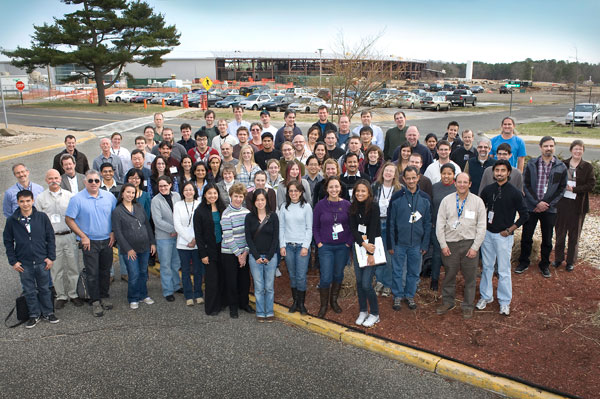50 Future Crystallographers Drawn to NSLS by RapiData 2011
June 8, 2011
About 50 students gathered at the National Synchrotron Light Source (NSLS) on April 3-8 for RapiData 2011, a weeklong crash course designed to introduce participants to the best and latest equipment and techniques for macromolecular x-ray crystallography.
RapiData allows students to meet and learn from the leading developers of software in the crystallography field, and then actually to use NSLS beamlines to collect data. This year marked the 13th consecutive year of the popular course, which is offered by BNL's Biology Department and Photon Sciences Directorate, and reflects an educational component of the PXRR (Macromolecular Crystallography Research Resource), funded jointly by the National Center for Research Resources, a branch of the National Institutes of Health (NIH), and by DOE's Office of Biological & Environmental Research.

RapiData participants in front of the NSLS-II construction site
X-ray crystallography allows scientists to determine the arrangement of atoms within a crystallized material based on the way x-ray light bounces off its electrons. This is especially important in determining protein and nucleic acid structures, which are needed to establish a fundamental understanding of life processes and for developing drugs and treatments for disease.
The course began with three days of lectures and tutorials taught by an international team of scientists from BNL, industry, academia, and other national labs. Next, the students were divided into groups and guided through a marathon data-collection session of two-and-a-half-days on eight NSLS beamlines. At the same time, many tutorials were under way, run by the lecturers themselves. Half the students brought their own specimens with the goal of solving the structure of a particular enzyme, while the other half observed and helped.
During the data-collection session, the students gathered each afternoon, and then on the final morning, to discuss their results. They produced mini lectures about their data and scientific subject, announcing about half a dozen new results.
"These are exciting little meetings, almost extemporaneous symposia," said Bob Sweet, of the Biology Department, who, with Sal Sclafani of the Medical Department and Alex Soares of Biology, coordinated the course. "The enthusiasm of these young researchers for their work, and for the new skills they are learning, is palpable."
In addition to DOE and NIH funding, a special grant was provided by the International Union for Crystallography to assist seven Latin American students in attending the course. Additional support was provided by Brookhaven Science Associates, Photon Sciences, and several equipment vendors and drug companies.
2011-2431 | INT/EXT | Newsroom









